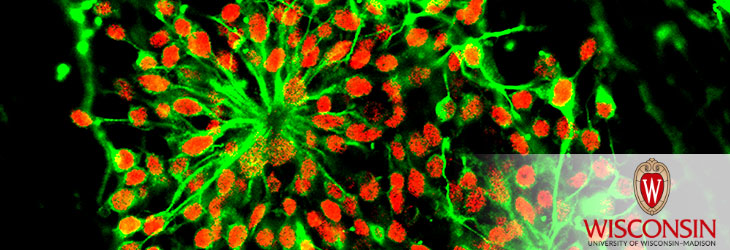Pluripotent Stem Cells

Functional Neutrophils from Induced Pluripotent Stem Cells
WARF: P190225US03
Inventors: Igor Slukvin, Vera Brok Volchanskaya, Kran Suknuntha, Anna Huttenlocher, David Bennin, Lucas Klemm
The Wisconsin Alumni Research Foundation is seeking commercial partners interested in functional neutrophils generated from iPSCs in chemically defined conditions using modified mETV2.
Overview
Despite recent advances in prevention and management, myelosuppression and febrile neutropenia are a complication of cancer therapies and a common cause of morbidity and mortality, especially in pediatric cancer patients. Granulocyte transfusion is used to treat neutropenia in various conditions, including septicemia and in pediatric patients resistant to antimicrobial therapies. However, many factors hamper the utility of granulocyte transfusion for correcting neutropenia and may contribute to inconclusive results observed in some clinical trials; such factors include the complicated logistics of granulocyte collection, the need for pre-treating donors with G-CSF or steroids, difficulties in collecting enough good quality granulocytes and the limited storage time (24 hours). Human induced pluripotent stem cells (hiPSCs) offer the potential to serve as a versatile and scalable source of neutrophils, and when further coupled with genetic engineering technologies, such approaches could be used to meet a variety of clinical needs.
The Invention
UW-Madison researchers have developed an efficient feeder- and xenogen-free rapid protocol for neutrophil generation from hiPSCs in GMP-compatible conditions. The three-step process begins with the direct hematoendothelial programming of hiPSCs using ETV2 modified mRNA. Next, the ETV2-induced hematoendothelial progenitors are cultured to lead to CD34+CD33+ myeloid progenitors that can be harvested every 8-10 days for up to 30 days of culture, and pooled. Finally, the myeloid progenitors are differentiated into neutrophils. Using this method, the researchers produced up to 1.7x107 neutrophils from 106 hiPSCs, and the resulting neutrophils displayed a typical somatic neutrophil morphology, produced reactive oxygen species, and possessed phagocytic and chemotactic activities
Applications
- Neutrophils generated from human iPSCs
Key Benefits
- Neutrophils could be used to treat neutropenic patients
Additional Information
For More Information About the Inventors
Tech Fields
For current licensing status, please contact Andy DeTienne at [javascript protected email address] or 608-960-9857